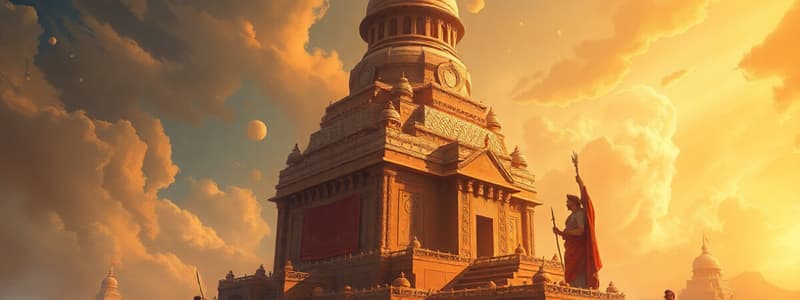Podcast
Questions and Answers
What was the primary occupation of the people during the Rig Vedic period?
What was the primary occupation of the people during the Rig Vedic period?
- Artisan crafts
- Pastoralism (correct)
- Agriculture
- Trade
Which of the following terms refers to original inhabitants of India during the Vedic period?
Which of the following terms refers to original inhabitants of India during the Vedic period?
- Gramini
- Dasyus (correct)
- Aryans
- Vajrapati
What role did the Samiti play in the political organization of the Rig Vedic period?
What role did the Samiti play in the political organization of the Rig Vedic period?
- It was a form of taxation.
- It was a ceremonial ritual.
- It was a tribal assembly. (correct)
- It was a military unit.
During the Later Vedic period, what strengthened the power of the king?
During the Later Vedic period, what strengthened the power of the king?
Which item was a standard unit of exchange during the Rig Vedic period?
Which item was a standard unit of exchange during the Rig Vedic period?
What was the primary religious focus of the society during the Later Vedic period?
What was the primary religious focus of the society during the Later Vedic period?
Which varna was associated with the priestly class during the Later Vedic period?
Which varna was associated with the priestly class during the Later Vedic period?
What term refers to the search for cows or war for cows in Rigvedic society?
What term refers to the search for cows or war for cows in Rigvedic society?
Which assembly was most important for decision-making in Rigvedic political organization?
Which assembly was most important for decision-making in Rigvedic political organization?
What was a significant change in the status of women during the Later Vedic period?
What was a significant change in the status of women during the Later Vedic period?
Flashcards are hidden until you start studying
Study Notes
Vedic Period: Rig & Later Vedic
- Rig Vedic Period (1500-1000 BC): The Aryan people migrated from Central Asia and Southern Russia to Northwest India, establishing Vedic civilization.
- Sapta Sindhawa (Land of Seven Rivers): The Aryans settled in the area encompassing the Indus River and its tributaries, including the Saraswati River.
- Dasrajan War: A battle between the Bharata King Sudas and ten other kings, marking the emergence of Bharata dominance.
Rig Vedic Political Organisation
- Tribal System: A tribal system of government, with military strength playing a key role.
- Jana: The tribe was known as Jana.
- Raja: The king was called Raja.
- Hereditary Kingship: While kingship was often hereditary, some evidence suggests election by tribal assemblies.
- Samitis: Tribal assemblies like Samitis, Sabha, Vidatha, and Gana played a significant role in decision-making.
Rig Vedic Economy
- Limited Revenue System: Kings relied on tributes (ball) and spoils of war for resources.
- Pastoralism: Pastoralism was the primary occupation, with agriculture secondary.
- Cows as Currency: Cows served as a standard unit of exchange.
- Staple Crops: Barley (Yava), gold (Nishka), Krishnal, and Satmana were staple crops.
Rig Vedic Terms & Rivers
- Dasyus: The original inhabitants of India.
- Ayas: Refers to copper and bronze.
- Vajrapati: An officer with authority over a large area of land.
- Kalapas: Head of the village.
- Gramini: Warriors or raiders, often involved in cattle raids.
- Gavisthi: The practice of cattle raiding or war for cows.
| River | Name in Rigveda |
|---|---|
| Indus | Sindhu |
| Kurram | Krumu |
| Jhelum | Vitasta |
| Chenab | Asikni |
| Parushni | Parushini |
| Beas | Vipas |
| Sutlej | Sutudri |
| Gomati | Gomal |
| Saraswati | Sarasvati |
| Ravi | Ravi |
| Ghaggar | Drishadavati |
Later Vedic Period (1000-500 BC)
- Expansion: The Aryans expanded from Punjab to Western Uttar Pradesh, covering the Ganga-Yamuna Doab.
- Rise of Kingship: The king (Samrat) gained more power, while tribal authority became more regional.
- Ashwamedha and Vajpeya Yajnas: Rituals like Ashwamedha and Vajpeya Yajnas were used to enhance the king's power.
Later Vedic Political Organisation
- Powerful Kingship: The King (Samrat) became more powerful, and tribal authority became more regional.
- Ashwamedha and Vajpeya Yajnas: Rituals like Ashwamedha and Vajpeya Yajnas were used to enhance the king's power.
Later Vedic Society
- Four Varnas: Society was divided into four varnas: Brahmana, Kshatriya, Vaishya, and Shudra.
- Deterioration of Women's Status: The position of women deteriorated.
- Emergence of Gotra: The institution of gotra (descent from a common ancestor) emerged.
- Nature Worship: People worshipped Nature, with Indra (also called Purandara - breaker of forts) being the most important deity.
- Soma Worship: Soma was regarded as the God of plants.
- Other Deities: Praja (children), Pashu (cattle) were worshiped for food, health, and wealth.
- No Temples: No temples or idol worship were noted in the Later Vedic period.
Later Vedic Administration
- Village Heads: Villages were headed by Gramani.
- Royal Advisors: The King was assisted by advisors like the Purohita (most important), Senani, and Gramani.
Later Vedic Religion
- Nature Worship: Worship of nature was common.
- Indra & Soma: Indra and Soma were the most important deities.
- No Idol Worship: Temples or idol worship were not prevalent.
Studying That Suits You
Use AI to generate personalized quizzes and flashcards to suit your learning preferences.




